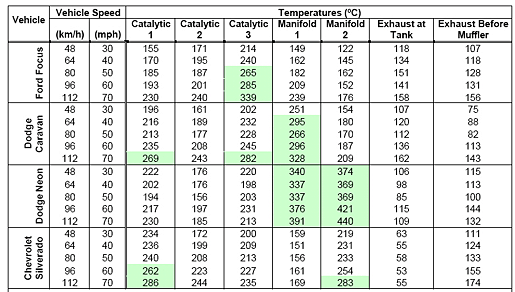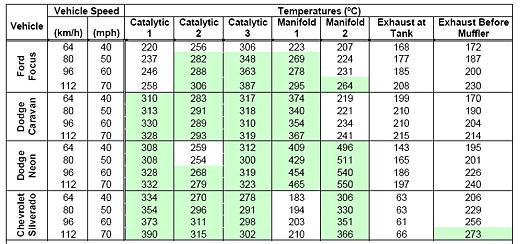Surface Temperatures
Detailed Information and References
Surface Temperatures
Detailed Information and References
Underhood Surface Temperature Tests: Summary of Published Results
1999 Ford Explorer [1]
Engine idle for approximately 1 hour at 1500-1800 RPM
Measurements made with welded thermocouples
| Left Exhaust Manifold Runner Cylinder 3 | 610oF |
| Left Exhaust Manifold Collector | 750oF |
| Right Exhaust Manifold Runner Cylinder 2 | 540oF |
| Right Exhaust Manifold Collector | 720oF |
| Left Exhaust Manifold Take-Down Pipe | 610oF |
1999 Honda Accord [2]
Engine idle for approximately 70 minutes at 1500-1800 RPM
Measurements made with welded thermocouples
| Left Exhaust Manifold Runner Cylinder 3 | 610oF |
| Right Exhaust Manifold Runner Cylinder 4 | 514oF |
| Right Exhaust Manifold Collector | 754oF |
| Left Exhaust Manifold Heat Shield Surface | 178oF |
1999 Chevrolet Camaro [3]
Engine idle for approximately 3 hours for the test vehicle, and 1 hour for the control vehicle, for 1500-1800 RPM
Measurements made with welded thermocouples
| Control Vehicle | Test Vehicle | |
| Right Exhaust Take-down pipe | 750oF | 720oF |
| Exhaust Manifold Runner Cylinder 1 | 790oF | 680oF |
| Right Exhaust Manifold Collector | 750oF | 900oF |
| Exhaust Manifold Runner Cylinder 4 | 970oF | 970oF |
| Exhaust Manifold Runner Cylinder 3 | 820oF | 750oF |
Two Camaros were used in full-scale burn tests. One was a control vehicle that had OEM parts; the test vehicle had an HVAC component made with flame-retardant chemicals. Both Camaros were running at high idle at the time of the crash test. The report also documented a 210 degrees F drop in the temperature of the control vehicle exhaust manifold runner for cylinder 4 within 3 minutes after the time of the crash test. It did not specify whether the engine remained running after the crash test.
1996 Dodge Caravan Sport [4]
| 34 mph | Idle for 11 min. (900 RPM) | Idle 900 RPM 11 minutes + ~1200 RPM 20 min. | |
| Exhaust gas (in manifold) | 1134oF | 802oF | 1008oF |
| Catalytic converter surface | 667oF | 396oF | 563oF |
| Front exhaust manifold surface | 275oF | 277oF | 282oF |
Instrumented tests of 4 vehicles [5]
Thermocouples attached with hose clamps
Qualification: This study was superseded by a later study by the same author [9] that showed the instrumentation used in the original study under report actual temperatures, potentially by a significant amount. There are few published studies of surface temperature, so values from the original paper [5] are used herein for reference only, and to represent the differences from one test condition to another. The absolute temperatures should not be relied upon.
Table 6: Summary of measured temperatures from the
hottest vehicle components
during the level road driving tests

Note: Cells that exceed the lowest autoignition temperature of underhood fluids are shaded
Table 7: Summary of measured temperatures from the
hottest vehicle components
during the uphill driving tests

Note: Cells that exceed the lowest auto ignition temperature of underhood fluids are shaded
The hill for these tests was a 7% grade.
Instrumented tests of 3 vehicles [6]
Thermocouples attached with hose clamps
Qualification: Because this study was conducted with thermocouples attached with hose clamps the absolute temperatures should not be relied upon and may underestimate the actual temperatures by a significant amount.
Tests were conducted comparing the effect on exhaust system surface temperatures for E85 (mixture of 85% ethanol and 15% gasoline) versus 100% gasoline. It was found that the surface temperature differences were minimal. Tests were performed on surface streets with speed limits from 25-70 mph and involved some variations in traffic conditions. Representative graphs (below) show the ranges of measured surface temperatures for both fuels throughout the 40 minute, 23 mile driving cycle.
References
Engine compartment surface temperatures - recent studies:
The following studies provide measurements made with infra-red (non-contact) thermometers that were not corrected for surface conditions. Measurements appear to include a large variability and should be used with caution.
Engine compartment surface temperatures - studies of older vehicles:
Studies of ignition temperatures